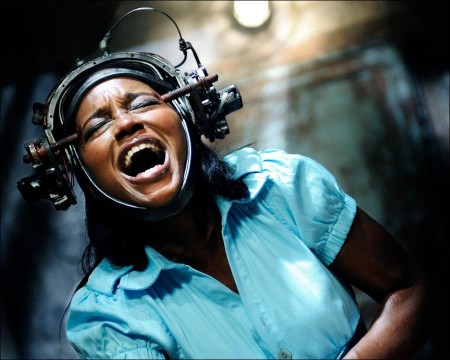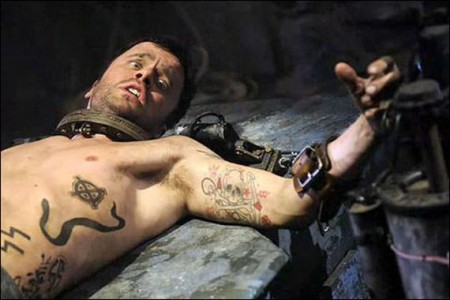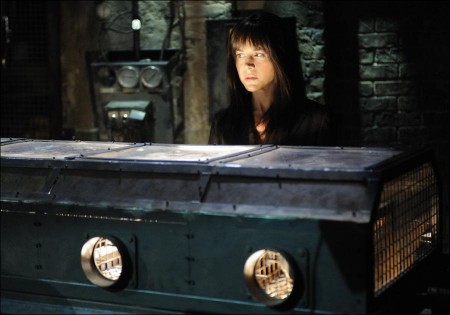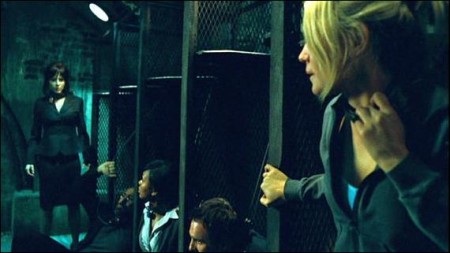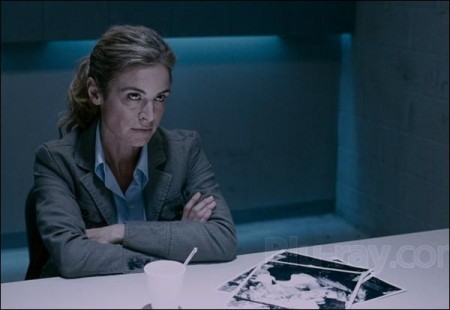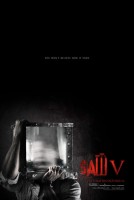In the fifth installment of the SAW franchise, Hoffman is seemingly the last person alive to carry on the Jigsaw legacy. But when his secret is threatened, Hoffman must go on the hunt to eliminate all loose ends.
Director David Hackl, who served at production designer on the first four SAW film, takes the helm in what promises to be a revelatory new installment in the franchise. “SAW V is going to answer a lot of questions for fans,” says the director. “It’s a story-driven SAW film, much like the first one, with some fine twists and turns. And the traps are more large scale because they involve more people. Fans can count on the same visceral, gut-wrenching, horrific traps that Jigsaw has always created, but taken to a whole new level.”
“What the fuck is going on? Where am I?”
Those words, uttered two minutes into 2004’s SAW, express the primal emotions – the hopeless confusion, the awful sense of powerlessness and sheer, panic-stricken terror – that lie at the heart of Lionsgate and Twisted Pictures’ SAW franchise; emotions that are a key to its phenomenal success. The SAW films follow the machinations of Jigsaw, a terminally ill cancer patient with an exacting moral agenda and a genius for gruesome games of survival, “played” with those he believes have ceased to value and appreciate the gift of life.
Ratcheting up tension and invention with each successive film, the SAW franchise has touched a chord while jangling millions of nerves worldwide. It has picked up the baton from classic horror series such as HALLOWEEN and NIGHTMARE ON ELM STREET to become a cultural touchstone, as well as the most profitable horror franchise, both theatrically and on DVD, in movie history. To date, the four SAW titles have taken in over $550 million in worldwide theatrical box office and their combined net DVD sales exceed 24 million units. The franchise has helped make Lionsgate the leading studio for horror today, with #1 rankings in box office and DVD consumer spending.
SAW made its world premiere at the 2004 Sundance Film Festival as part of the Festival’s popular “Park City at Midnight” program. Festival Director Geoffrey Gilmore, who programs the annual event, recalls that he was impressed by the first-time filmmakers’ command of both form and theme. “SAW grabbed the viewer from the first frame; it was bold, cleverly constructed and flat-out terrifying,” he comments. “But what really set SAW apart was its moral seriousness. This movie didn’t just want to scare you, it wanted to make you think about what you would do to stay alive. In today’s world, that is not a trivial thing to contemplate — either as an individual or as a member of society.”
As the SAW series has continued, the films have tunneled further into Jigsaw’s beliefs and worldview. Says Leigh Whannell, who created the original story with director James Wan and wrote or co-wrote the screenplays for SAW, SAW II and SAW III, “Jigsaw’s cancer has led him to think very hard about what it means to be alive and how close we are to death at any given time. But he’s not someone who stops with a simple `carpe diem’ and a trip to placeEurope. The concept of life’s value becomes a springboard to look at other personal moral choices, like forgiveness versus retribution. Jigsaw keeps digging into these issues, which become grist for his games. And as twisted as the games are, his intention is to help people. Between his philosophical bent and his sick take on altruism, I like to think Jigsaw is somewhat unique in the horror universe.”
The SAW franchise has been part of a wave of horror films that have drawn favorable comparisons to the independent horror cinema of the 1970s, a connection highlighted in a Summer 2007 series at New York’s Museum of the Moving Image, entitled “It’s Only a Movie: Horror Films from the 1970s and Today.” The six-weekend retrospective drew a thru-line between films like Wes Craven’s LAST HOUSE ON THE LEFT (1972) and Tobe Hooper’s TEXAS CHAINSAW MASSACRE (1974), which shocked audiences of their day with envelope-pushing gore and disturbing explorations of human behavior; and the films of the SAW age, including Darren Lynn Bousman’s SAW II, which contain images and stories that have left today’s viewers just as stunned and terrified — and eager for more — as the moviegoers of the 1970s. “It’s Only a Movie” presented double features that paired films from each era, with SAW II sharing a bill with Stanley Kubrick’s A CLOCKWORK ORANGE.
Announcing the series in June 2007, the Museum’s Chief Curator, David Schwartz said, “These movies are of considerable aesthetic and cultural interest, clearly reflecting the fears of contemporary lives…. Of course we are aware that these films contain disturbing, often shocking images, but they are powerful precisely because they tap into our deepest anxieties.”
Assistant Curator Livia Bloom also weighed in. “The filmmakers in this series use the horror genre as a commercial framework to make smart, often subversive films. Their work examines deep psychological concerns, and comments on social and political issues of the day.” Bloom noted that in SAW’s “startling scenes of torture,” she found “reflections of a life during a time of war and turmoil.”
The thematic and stylistic consistency of the SAW series owes much to the stewardship and participation of a core team, including SAW originators James Wan and Leigh Whannell; writer / director Darren Lynn Bousman, who joined the team with SAW II; producers Oren Koules, Mark Burg and the late Gregg Hoffman; and executive producers Stacey Testro, Peter Block and Jason Constantine. The key creative team has been with the series from the start, and includes director of photography David A. Armstrong; production designer, and current director David Hackl; editor Kevin Greutert; and composer Charlie Clouser, a onetime member of the band Nine Inch Nails.
Another critical member of the SAW team is actor Tobin Bell, who has portrayed Jigsaw throughout the franchise. In his September 7, 2007 essay on contemporary horror movies in the L.A. Weekly, critic Luke Thomson wrote, “Tobin Bell’s performance as Jigsaw is a wonder; he’s the best `real-world’ horror antihero since Anthony Hopkins first played Hannibal Lecter.”
As intricate as one of Jigsaw’s games, the SAW films reveal their twisting plots gradually. The series itself resembles an even larger jigsaw puzzle, with each new film linking up in some way with its predecessor. With SAW V arriving in theatres for Halloween 2008, let’s take a look at the pieces thus far. To paraphrase Jigsaw’s victims: where are we?
Saw
Director: James Wan
Screenwriter: Leigh Whannell
Story by James Wan and Leigh Whannell
SAW’s opening scene immediately plunges the audience into the unknown, along with the two unfortunate men, Adam (Leigh Whannell) and Dr. Lawrence Gordon (Cary Elwes), who wake to find themselves chained up in a fetid subterranean bathroom. The captives are the most recent targets of a psychopathic genius known as Jigsaw, who constructs elaborate games that force his victims to make impossible choices between life and death. As Adam and Dr. Gordon struggle to unravel the elaborate puzzle of their fate, Detective Tapp (Danny Glover) and his colleague Kerry (Dina Meyer) work furiously to determine Jigsaw’s identity before he can claim yet more victims. But Jigsaw has accomplices – whose willingness is not entirely clear – and his meticulous planning enables him to escape.
SAW opened nationwide on Friday, October 29, 2004. The film stunned industry observers by debuting at #3 with a weekend take of $18.4 million and it remained in the Top 10 for 4 weeks. Produced for just $1.2 million, SAW went on to worldwide box office earnings of over $102 million ($55.1 domestic, $47.7 international). It won the Audience Award for Best Feature at the 2004 San Sebastián Horror and Fantasy Film Festival. SAW was released on DVD/home video on February 15, 2005; it debuted at #1 on the home entertainment charts and sold 2.8 million units in its first week. It was the top-selling horror DVD of 2005.
Saw II
Director: Darren Lynn Bousman
Screenplay: Leigh Whannell and Darren Lynn Bousman
SAW II finds Jigsaw playing two games simultaneously: one involving eight victims who wake up in a crumbling house and must solve their mastermind’s riddle before their insides are destroyed by poison; and the other with Detective Eric Matthews (Donnie Wahlberg), whose rebellious son is among the eight captives. Also among the abducted is Amanda (Shawnee Smith), who was introduced in SAW as the only victim to have survived Jigsaw’s tests. Desperate to save his son, Detective Matthews resorts, not for the first time, to brutality and trickery. It’s a decision that leads him right into a trap designed by Jigsaw in collaboration with his new apprentice: Amanda.
SAW II opened nationwide on Friday, October 28, 2005. It was the weekend’s #1 film with a box office tally of $31.7 million, outperforming SAW’s opening weekend by $12 million, an increase of approximately 60%. SAW II spent 7 weeks in the U.S. Top Ten, and was the most profitable horror film of 2005, with domestic theatrical box office receipts of $87 million. Internationally, SAW II opened at #1 in Australia, Brazil, Germany and Austria; its combined international box office was $66.4 million.
SAW II was released on DVD/home video on Valentine’s Day, February 14, 2006; it debuted at #1 on the home entertainment charts, selling 2.5 million units on its first day and 3.5 million units in its first week. It was nominated for the 2006 Saturn Award for Best Horror Film by the Academy of Science Fiction, Fantasy & Horror Films, USA; star Tobin Bell was nominated for the 2006 MTV Movie Award nomination for Best Villain.
Saw III
Director: Darren Lynn Bousman
Screenplay: Leigh Whannell
Story: Leigh Whannell and James Wan
As SAW III begins, Jigsaw’s health is failing and he is preparing his adoring acolyte, Amanda, to carry on his work. Amanda has designed numerous games herself, building various horrendous contraptions to test the survival instincts of her victims. A very important game involves a brain surgeon, Lynn (Bahar Soomekh), who is forced to operate on the dying man. Meanwhile, in another section of Jigsaw’s lair, a grieving father, Jeff (Angus Macfadyen) is given the barbed opportunity to fulfill his dreams of revenge. Like so many before him, Jeff lives down to Jigsaw’s expectations … with dire consequences for the people he loves.
SAW III opened nationwide on Friday, October 27, 2006. It was the weekend’s #1 film with a box office tally of $33.6 million, the biggest opening in Lionsgate history. It spent 4 weeks in the U.S. Top Ten, and was the most profitable horror film of 2006, with domestic theatrical box office receipts of $80.2 million. SAW III’s international box office receipts also totaled $82 million, and it marked the first Lionsgate film to open at #1 in Great Britain, where it took in $4.9 million in its first weekend.
SAW III was released on DVD / home video on January 23, 2007, debuting at #1 on the charts, selling 1.6 million units in the U.S. and Canada on its first day and 2.5 million units in its first week. It was the best-selling horror DVD of 2007, having sold 4.1 million units. SAW III was nominated for the 2007 Saturn Award for Best Horror Film by the Academy of Science Fiction, Fantasy & Horror Films, USA; star Tobin Bell was nominated for the 2007 MTV Movie Award for Best Villain; Bell and Shawnee Smith received a joint Spike TV Scream Award nomination for Most Vile Villain.
Saw IV
Director: Darren Lynn Bousman
Screenplay: Patrick Melton & Marcus Dunstan
Story by Patrick Melton & Marcus Dunstan and Thomas Fenton
Given that Jigsaw dies at the end of SAW III, it’s a testament to the ingenuity of the franchise that Jigsaw remains a prominent character in SAW IV. Says director Darren Lynn Bousman, “Jigsaw’s death in SAW III left us with a major creative challenge, but also a very exciting one. We had to do something really smart and different with this movie, lest we fall prey to sequel-itis or self-parody. SAW IV became an opportunity to up the ante and go even deeper into Jigsaw’s story, his philosophies and obsessions. Given whom Jigsaw is and what he’s done, we think it makes for quite a horrifying journey.”
SAW IV opened nationwide on October 26, 2007. It was the weekend’s #1 film with a box office tally of $31.7 million. It has since earned total domestic theatrical box office receipts of $63 million; the film’s international box office receipts have totaled over $73 million. SAW IV was released on DVD/home video on January 22, 2008, debuting at #2 on the charts and selling 2.6 million units in the U.S. and Canada. It is one of the top two best-selling horror DVDs of 2008. SAW IV has been nominated for three Spike TV Scream Awards (Best Sequel, Best Villain, Most Memorable Mutilation), to be handed out October, 2008.
Giving Til It Hurts: The Animal Saw Blood Drive
The SAW franchise is not only about big-screen blood; it also about the blood that saves lives. With the release of the first SAW in 2004, Lionsgate and Twisted Pictures embarked on a cutting-edge promotion tailored specifically to the franchise’s profile: a nationwide SAW blood drive that exhorts fans to “Give Til It Hurts” to benefit the Red Cross. The SAW “Give Til It Hurts” Blood Drive has become a key element of the SAW franchise, as much a part of its annual rituals as the Halloween premiere date.
Each year brings a new ad campaign photographed by Tim Palen, Lionsgate Co-President of Theatrical Marketing and fine art photographer, and featuring the SAW nurses, seductive angels of questionable mercy and considerable visual impact. In the first four years of the blood drive, SAW filmgoers donated nearly 80,000 pints of blood to help save as many as 238,000 lives.
For the 2007 drive, the SAW “Give Til It Hurts” Blood Drive acquired two important new partners, the American Red Cross and Yahoo!, to help make the campaign bigger, better and more bloodily ambitious than ever. Lionsgate and the American Red Cross entered into their first formal partnership to administer the SAW IV Blood Drive on a nationwide basis. The national organization teamed with local Red Cross chapters to set up donation centers, a commitment that more than quadrupled the number of centers, from 250 to 1200. SAW star Tobin Bell was featured in several PSA’s advertising the event.
Meanwhile, Yahoo! provided massive online support for the SAW IV Blood Drive as Lionsgate and Twisted Pictures’ key online partner. In addition to providing hundreds of millions of impressions across Yahoo! News, Yahoo! Mail, and Yahoo Movies, Yahoo! also hosted the Blood Drive website. By searching for “Saw Blood Drive” on Yahoo!, users were able to access the SAW IV Blood Drive website, which featured a branded, interactive Yahoo! Map that allowed users to find the closest Blood Drive to their geographic location. In addition to the interactive map, users could watch the Blood Drive PSA with Tobin Bell, grab branded downloads, and tell a friend about the Blood Drive. Both the Red Cross and Yahoo! reteam with Lionsgate for the 2008 blood drive effort.
The SAW V Blood Drives are taking place at college campuses and other locations across the country. Field drives began the week of September 26, 2008 and Red Cross blood drives began the week of September 23rd. The SAW V Blood Drive will continue through the first week of the film’s release.
The SAW IV blood drive gathered 41,784 pints, over 3000 pints more than the previous three years combined and saving approximately 125,350 lives. Collection totals from the SAW blood drives have doubled year after year: during the 2004 inaugural drive, 4,200 pints were collected, in 2005, 10,000 pints were collected, and in 2006, 23,493 pints were collected, resulting in tens of thousands of lifesaving blood transfusions.
Production notes provided by Lionsgate Films.
Saw V
Starring: Tobin Bell, Costas Mandylor, Betsy Russell, Mark Rolston, Julie Benz, Greg Bryk, Meagan Good
Directed by: David Hackl
Screenplay by: Marcus Dunstan
Release Date: October 24, 2008
MPAA Rating: R for for sequences of grisly bloody violence and torture, language and brief nudity.
Studio: Lionsgate Films
Box Office Totals
Domestic: $56,746,769 (50.2%)
Foreign: $56,359,866 (49.8%)
Total: $113,106,635 (Worldwide)

